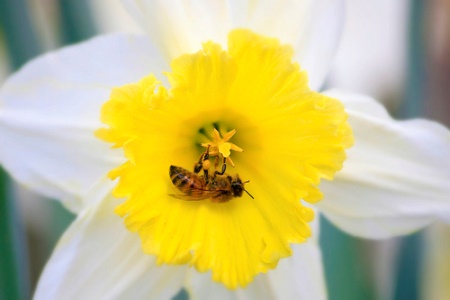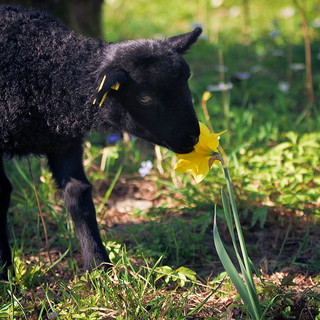Important Interactions
The wild daffodil's interactions are diverse
and crucial to the plant's survival. The most important
interaction that this plant undergoes is the process of
pollination, which can occur with many different species.
In order to fertilize the daffodil's ovule, pollen must be transported, usually by insects, from the stamen of a different daffodil plant. This pollen dusts the feet of organisms such as bees and butterflies. Some examples of insects that help the daffodil become fertilized include the rusty-patched bumble bee, the European honey bee, and the monarch butterfly. These insects become attracted to the daffodil's bright flowers, seeking the plant's nectar for nourishment. When the insect lands on the flower, pollen collects on the insect's feet. The insect, after getting its fill of the daffodil's nectar, flies to another plant of the same species, distributing the pollen so that it fertilizes the second plant. Insects are pivotal to the propagation of wild daffodils. This is a mutualistic relationship, meaning that both organisms benefit from the interaction. The insect receives nutrition from the daffodil, and the daffodil's pollen is transported by the insect in order for reproduction to occur successfully.
Narcissus pseudonarcissus undergoes daily interactions with such insects, providing essential food for the flying pollinators. However, the daffodil is not a plant that other animals have a desire to eat. The daffodil contains deadly poison in the form of alkaloids. If enough of the plant is consumed, the alkaloids can cause serious harm to animals that would eat it, including humans. The daffodil's poison and the effects thereof are discussed more on the facts page.
 Another interaction that is
sometimes overlooked is the relationship between the
wild daffodil and mycorrhizal fungi. These fungi
grow around the daffodil's roots, forming a usually
mutualistic relationship. The mycorrhizae help the
plant absorb nutrients more efficiently and grow
more quickly. In return, the fungus receives
much-needed carbon from the plant.
Another interaction that is
sometimes overlooked is the relationship between the
wild daffodil and mycorrhizal fungi. These fungi
grow around the daffodil's roots, forming a usually
mutualistic relationship. The mycorrhizae help the
plant absorb nutrients more efficiently and grow
more quickly. In return, the fungus receives
much-needed carbon from the plant.
In a food web, the wild daffodil would be classified as a primary producer, providing nutrition for insects and not much else. The toxicity of the daffodil's poison causes adverse effects in specific quantities, causing most herbivores to avoid it entirely. The lamb in the picture below will probably undergo some unpleasant consequences from consuming a daffodil for its meal.
 As for humans, the interactions
between daffodils and people are quite common,
though the plant is clearly not used for food. Wild
daffodils are a beautiful addition to any garden,
and their adaptations make the plant a hardy
survivor through difficult growing seasons. You can
learn more about the daffodil's distinctive
attributes on the
adaptation
page.
As for humans, the interactions
between daffodils and people are quite common,
though the plant is clearly not used for food. Wild
daffodils are a beautiful addition to any garden,
and their adaptations make the plant a hardy
survivor through difficult growing seasons. You can
learn more about the daffodil's distinctive
attributes on the
adaptation
page.
Though humans come in contact with
Narcissus pseudonarcissus on a fairly
regular basis, they too can suffer from the
daffodil's toxic properties. One major result of
working with wild daffodils is a rash known as
"daffodil itch." If sap from the daffodil touches
human skin, a rash resembling eczema will form on a
person. Sores can develop at the site of the rash,
and it becomes quite painful for the affected
victim. Most "daffodil itch" rashes are confined to
the wrists and hands of humans, as a result of
harvesting the plants manually. After a couple
weeks, the rash will eventually fade as long as
further contact with the daffodil plant is not made.
However, it is simple for people to avoid this
unpleasant consequence by wearing protective
clothing. Waterproof gloves can shield the skin from
coming in contact with sap.
Follow this link to revisit the homepage.